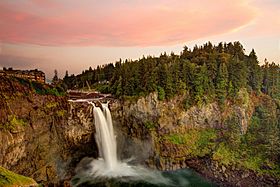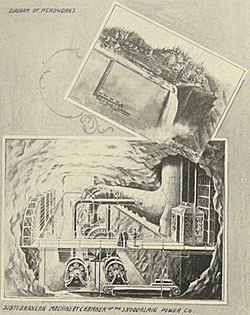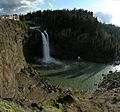Snoqualmie Falls facts for kids
Quick facts for kids Snoqualmie Falls |
|
|---|---|

September 2012
|
|
| Lua error in Module:Infobox_mapframe at line 185: attempt to index field 'wikibase' (a nil value). | |
| Location | West of Snoqualmie, Washington, U.S. |
| Coordinates | 47°32′29″N 121°50′14″W / 47.5415°N 121.8373°W |
| Type | Curtain |
| Total height | 268 ft (82 m) |
| Number of drops | 1 |
| Average width | 100 ft (30 m) |
| Watercourse | Snoqualmie River |
|
Snoqualmie Falls
|
|
| Lua error in Module:Location_map at line 420: attempt to index field 'wikibase' (a nil value). | |
| Location | Snoqualmie River below crossing of State Route 522, King County, Washington |
| Nearest city | Snoqualmie, Washington |
| NRHP reference No. | 92000784 |
| Added to NRHP | September 2, 2009 |
Snoqualmie Falls is a huge waterfall, 268 feet (about 82 meters) tall, located in the northwest United States. You can find it east of Seattle on the Snoqualmie River, between the towns of Snoqualmie and Fall City, Washington.
This waterfall is one of Washington's most famous natural sights. It even became known around the world because it appeared in the TV show Twin Peaks. Over 1.5 million people visit Snoqualmie Falls every year! There's a park, a viewing deck, and a gift shop for visitors to enjoy.
Most of the river's water is sent to power plants, but sometimes the river gets very full. After heavy rains or snow, the water can flow over the entire edge of the falls. This creates a powerful spray that can be almost blinding! When this happens, the falls look like a giant water curtain.
For the Snoqualmie People, who have lived in the Snoqualmie Valley for a very long time, Snoqualmie Falls is super important. It's central to their culture, beliefs, and spiritual life. They see the falls as a traditional burial site and believe it's "the place where First Woman and First Man were created." They also believe that prayers are carried to the Creator by the mists rising from the powerful waterfall. These mists are said to connect Heaven and Earth.
In 2009, Snoqualmie Falls was officially added to the National Register of Historic Places. This special listing recognized its importance to the Snoqualmie people's beliefs. Later, in 2019, the Snoqualmie Indian Tribe bought the Salish Lodge and 45 acres of land around the falls for $125 million.
Contents
History of Snoqualmie Falls
Protecting the Falls and Land
In 2007, the Muckleshoot tribe bought the Salish Lodge, which is near the falls. They planned to build a new hotel, a conference center, and 175 homes close to Snoqualmie Falls.
However, members of the Snoqualmie Indian Tribe were against this plan. They were worried because the proposed buildings would be very close to their sacred burial grounds and the falls themselves. In 2015, the Snoqualmie Indian Tribe started a campaign called "Save Snoqualmie Falls" to protect the area.
After many discussions, the Muckleshoot tribe received permission in October 2018 to build a 182-room hotel, a convention center, and up to 210 homes. But the Snoqualmie Indian Tribe had another plan.
On October 31, 2019, the Snoqualmie Indian Tribe successfully bought Snoqualmie Falls, the Salish Lodge and Spa, the gift shop, and 45 acres of land nearby. They paid $125 million for it! This important purchase stopped the Muckleshoot's building plans. The tribe announced their purchase the next day, saying it was a step to "reclaim its traditional lands" and "stop irresponsible development." The Salish Lodge will still be managed by a company called Columbia Hospitality.
How Snoqualmie Falls Makes Power
The Snoqualmie Falls Hydroelectric Plant uses the power of the waterfall to create electricity. It's run by Puget Sound Energy and has two main power houses: Plant 1 and Plant 2.
Plant 1 was built in 1899. It's very special because it's located deep inside the rock, 270 feet (about 82 meters) below the surface, right at the base of the falls. It was the world's first power plant built completely underground!
Plant 2 was built later, in 1910, and was made even bigger in 1957. It's a short distance downstream from the falls. Together, these plants produce about 1% of the electricity sold by Puget Sound Energy. In 1981, the 1899 power system was recognized as an important Civil Engineering Landmark.
The Town of Snoqualmie Falls
There used to be a town called Snoqualmie Falls right near the waterfall. It was connected to a large lumber mill run by Weyerhaeuser. The town had many buildings, including a hospital, a school, a community center, and lots of homes. When the town closed down, many of its houses were moved to the nearby town of Snoqualmie. The famous film actress Ella Raines was born in Snoqualmie Falls in the 1940s and '50s.
Visiting and Hiking at the Falls
The top of the waterfall is very easy to reach, less than 100 yards (about 91 meters) from the parking lot. At the parking lot, you'll find a gift shop, a coffee stand, and restrooms. The best views of the falls are from the side, where a fence keeps visitors safe from the edge of the cliff. This area also has picnic tables, benches, and a small grassy area called the Centennial Green, where weddings sometimes take place in the summer.
From here, a river trail goes down 374 feet (about 114 meters) over 0.7 miles (1126 meters). As you walk, you'll pass through a cool, damp forest with trees like Bigleaf Maple and Douglas-fir, and plants like Sword Fern and Salal. There are places to stop and rest or just enjoy the beautiful scenery. Because many people use the trail, it's not common to see a lot of wildlife, but pets are allowed in the park. At the bottom of the trail, you'll find the 1910 powerhouse (which isn't open to visitors) and another great view of the falls.
Gallery
-
Brink of falls, Spring 1890 - Frank Jay Haynes
See also
- Run-of-the-river hydroelectricity











